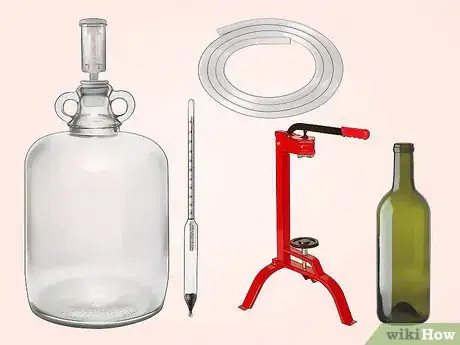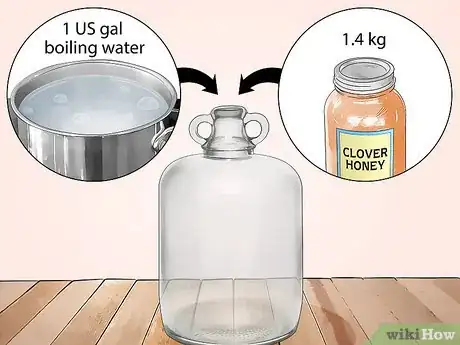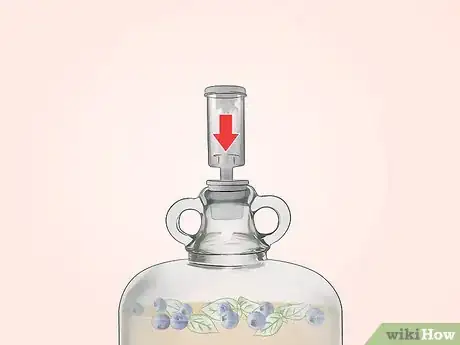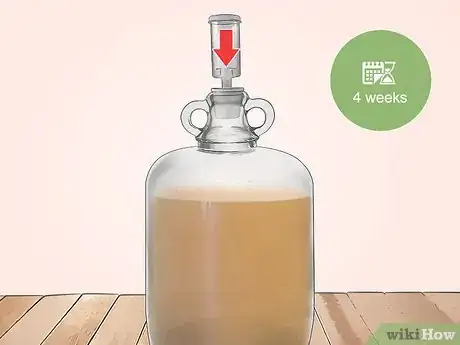This article was co-authored by wikiHow Staff. Our trained team of editors and researchers validate articles for accuracy and comprehensiveness. wikiHow's Content Management Team carefully monitors the work from our editorial staff to ensure that each article is backed by trusted research and meets our high quality standards.
wikiHow marks an article as reader-approved once it receives enough positive feedback. This article received 11 testimonials and 93% of readers who voted found it helpful, earning it our reader-approved status.
This article has been viewed 1,049,510 times.
Learn more...
Mead is one of the oldest alcoholic drinks known to man. It is essentially a wine made from fermented honey and is relatively easy to produce. The three main ingredients are water, honey, and yeast, and with the proper equipment, you can make your own mead at home. The original recipee calls for Filipendula (mead herb), to be added, otherwise it's called honeywine. Recipee for that as follows.
Ingredients
- 1 gallon (3.8 L) of chlorine-free water
- 3 pounds (1.4 kg) of honey
- 1 gram of white wine yeast
- 1 pound (0.45 kg) of fresh fruit (optional)
- 1 cup (~25 g) of fresh herbs (optional)
- 2 tbsp (~3 g) of dried herbs (optional)
- 2 tbsp (~14 g) of spices (optional)
Yields 1 gallon (3.8 L) of mead
Steps
Getting Started
-
1Get a basic brewing kit. You will need some basic equipment in order to properly make your mead.[1] You can find basic home brewing kits from brewing supply stores, and online. The kit should contain:
- A bucket or carboy to hold the fermenting mead. The container should also have an airlock on it to allow the gasses that are released during fermentation to escape the container while keeping it sealed from contamination.
- A hydrometer to allow you to calculate the alcohol by volume (ABV) level and see if the batch is still fermenting.
- A siphon to allow you to transfer the liquid without disturbing the sediment that builds up.
- Bottling equipment like a capper and glass bottles or a corker and wine bottles so you can bottle your finished mead.
-
2Use clover honey for a traditional mead. Different types of honey can add different flavor profiles to your mead, so choose one that you enjoy.[2] Clover honey is the basic honey you’ll find in the grocery store. It has the classic sweet honey taste, and is a great honey for mead making. You can choose different types of honey to alter the aromatics and the taste of your mead.
- Orange blossom honey will add flavor notes of oranges.
- Buckwheat honey has a strong flavor, similar to molasses.
- Wildflower honey can be a random mix of local floral sources, and the flavors can be impossible to predict.
- For a simple 1 gallon (3.8 L) batch of mead, you’ll need at least 3 pounds (1.4 kg) of honey, so make sure you get enough!
Advertisement -
3Add fruit, herbs, and spices to alter the flavor of your mead. You can also manipulate and alter the flavor profile of your mead using fresh fruits and spices. Spices like nutmeg and clove, fruits like blueberries or cherries, and herbs like lemongrass and basil can dramatically change the flavor notes in your mead, and give it a unique character. Just be sure not to overpower the natural sweetness of the mead.[3]
- Ginger, vanilla, citrus peels, coriander, cinnamon, nutmeg, even chocolate can be added to mead to change the characteristics of its taste and aromatics.
- Use fresh fruit instead of dried or dehydrated fruit as they can affect the fermentation process.
-
4Use white wine yeast to ferment the mead. Yeast is one of the three main ingredients for making mead, so it’s important to choose the right one for your mead.[4] White wine yeast ferments at a fast pace, and accents the honey characteristics of the mead. You can find white wine yeast and other yeasts at brewing supply stores and online.
- You can use other types of yeasts, but they will each have different results and flavor profiles. For example, champagne yeast will create a higher ABV, while red wine yeast is great for mead with lots of fresh fruit because it metabolizes fresh sugars better.
- You can also use standard bread yeast as an easy alternative that will give you a smooth mead without altering the character of the honey flavor.
-
5Boil all of your brewing equipment in a large pot of water. All of the equipment and utensils that you will use to make your mead must be completely sanitized. An easy way to do this is to boil all of the equipment you will be using for 5 minutes, or use a special sanitizer that comes with many homebrewing kits. Any bacteria or contamination that gets in can ruin an entire batch of mead.[5]
- Sanitize any spoons, tubing, bottles, containers, or other utensils that you may use.
- Be sure to rinse your equipment of any cleaning solutions that you use, as this can introduce unwanted chemicals and ruin the taste of your mead.
Brewing the Must
-
1Mix 1 US gal (3.8 L) of water and 3 lb (1.4 kg) of honey in your bucket or carboy. The first stage of making mead is a mixture called a “must.” Bring the water to a boil in a large pot and add it to the container you will ferment your mead in, then stir in honey. Do not add the honey to the boiling pot of water or it will alter the flavor of the honey, and the honey may stick to the bottom of the pot.[6]
- Make sure the honey has fully combined with the water before moving on.
-
2Add your fruit, spices, and herbs to the container of must. Once the honey has fully combined with the water, you can add your fruit and spices to the must. Place your fresh fruit into the mixture without smashing or muddling the fruit to avoid changing the color of the mead. Add your tea bag full of spices and herbs into the liquid and give it a nice stir.[7]
- For fresh fruit, add 1 pound (0.45 kg) per 1 gallon (3.8 L) of water.
- For spices like nutmeg and cinnamon, add 2 tbsp (~14 g) per 1 gallon (3.8 L) of water.
- For fresh herbs, add 1 cup (~25 g) per 1 gallon (3.8 L) of water. For dried herbs, add 2 tbsp (~3 g) per 1 gallon (3.8 L) of water.
-
3Use a hydrometer to check the specific gravity of the must. After you’ve combined the ingredients to form the must, you can use a hydrometer to check the specific gravity of the mixture. This will allow you to determine the potential alcohol content of your mead. It’s important to check the gravity of the must before you add your yeast because it will be difficult to alter the mixture once the yeast begins working to ferment the must.[8]
- The baseline reading of your must should be somewhere between 1.060 and 1.120 on the hydrometer.
-
4Add the yeast to the must. Once you’ve got the must flavor profile and ABV that you want, it’s time to add the yeast. A standard packet of brewing yeast is enough for up to 5 gallons (19 L) of mead, so use 1 gram (or one-fifth of the packet) if you're only making 1 gallon (3.8 L) of mead. Simply stir the yeast into the must and mix it in thoroughly.[9]
- Adding too much yeast will only make the fermentation process go a little faster and will not damage or alter the taste of your mead.
-
5Seal the container of must and attach an airlock with a rubber stopper. When the enzymes in the yeast begin to break down the sugars in the honey, it will release gasses that can build up in the container and potentially explode. Use a rubber stopper that fits over the opening in the container, then place the stem of the airlock into the hole of the rubber stopper, and place them both into the opening of the container. It’s important that you have an airlock so you can release the gasses while keeping the mead free from any contamination. [10]
- Whether you’re using a plastic container or a glass carboy, it needs to be sealed so the fermentation process can begin, and an airlock is needed to allow the gasses to escape.
Fermenting and Bottling the Mead
-
1Stir the container twice a day for the first 48 hours to begin fermentation. To get the fermentation process started, you’ll need to mix the ingredients twice a day for the initial 48 hours, but not past that period.[11] Make sure any utensils you use to stir the mixture are fully sanitized so you don’t introduce any bacteria into the container or the mead. Stir the mixture for about 2 minutes or so, and be sure to seal the container when you are done.
- If you are fermenting the mead in a carboy or a container with a narrow opening at the top, you can lightly shake the container to mix it.
-
2Wait 10 days then siphon the mead into a clean container from the top. During the fermentation process, a layer of sediment will form at the bottom of the container. Use a siphoning hose or tube to transfer the mead into another clean container to separate it from the sediment. Place the container of mead on a higher surface level, insert a siphon hose in the mead, and shake the hose up and down to start the flow of liquid into a clean container below it.[12]
- Place the siphoning tube at the top of the liquid so you don’t transfer any sediment.
- The clean container should be large enough able to hold all of the mead. If the new container does not have a rubber stopper and airlock, you can clean the sediment out the original container, sanitize it, and add the mead back into it to continue fermenting.
- Check the ABV again with the hydrometer to track the progress of the fermentation.
- Make sure the new container is sterilized.
-
3Seal the clean container and allow it to sit for at least 4 weeks. Once you’ve siphoned the mead and separated it from the sediment in the container, seal the new container with an airlock to allow the gasses to escape. Store the container in a warm dry place for a few weeks to continue the fermentation process. Eventually, sediment will collect on the bottom of that container as well, siphon the liquid into another clean container to separate it from the sediment again.
- Siphoning, or “racking,” to separate the mead from the collected sediment may need to be repeated several times during the fermentation process. Repeat the racking process until your mead is clear and no longer cloudy.[13]
-
4Check the ABV of your mead before you bottle it. After your mead has fermented for at least a few weeks, it may be ready for bottling. But you need to take another reading with your hydrometer to confirm that the alcohol by volume (ABV) is where you want it to be.[14] Different tasting meads will have different readings:
- Dry tasting mead will read between 0.099 to 1.006.
- Medium tasting mead that is slightly sweet and slightly dry will read between 1.006 to 1.015.
- Sweet mead will fall between 1.012 to 1.020.
- Very sweet dessert mead will read anywhere past 1.02.
-
5Fill your bottles from the bottom up. Once your mead is finished and ready for final bottling, use a siphon to transfer the mead from the container. Put a length of tubing from the container of mead to the bottom of the empty bottle, shake the hose up and down in the mead to start the flow, and fill the bottles from the bottom up to minimize exposure to oxygen. Cap or cork the bottles as soon as you finish filling them. You can enjoy the mead whenever you like, but the longer it ages, the more flavorful it will be.[15]
- The bottles and equipment must be sanitized to avoid tainting or spoiling the mead.
- Stored in a cool place away from direct sunlight, your mead can last up to 2 years!
Community Q&A
-
QuestionHow can I tell what proof my alcohol is?
 Community AnswerYou would use a gauge to tell the specific gravity of the solution before fermentation, which shows the maximum potential alcohol level.
Community AnswerYou would use a gauge to tell the specific gravity of the solution before fermentation, which shows the maximum potential alcohol level. -
QuestionWhat is champagne yeast? Is it okay to use it?
 Community AnswerThere are a few strains of yeast used to make champagne, sparkling wine and cider. A highly common strain would be Lalvin EC-1118. EC-1118 would be a good choice for mead due to its high alcohol tolerance and acceptable temperature range. Addition of a yeast nutrient and energizer will help this strain to thrive.
Community AnswerThere are a few strains of yeast used to make champagne, sparkling wine and cider. A highly common strain would be Lalvin EC-1118. EC-1118 would be a good choice for mead due to its high alcohol tolerance and acceptable temperature range. Addition of a yeast nutrient and energizer will help this strain to thrive. -
QuestionHow much alcohol does the final product have? How much yeast do we need? Does it cause problems if we use usual water?
 Community AnswerAlcohol content varies based on the type of yeast you use, how much honey or other sweetener you use and how long you allow your mead to ferment. Tap water is fine.
Community AnswerAlcohol content varies based on the type of yeast you use, how much honey or other sweetener you use and how long you allow your mead to ferment. Tap water is fine.
Things You’ll Need
- Homebrewing kit
- Hydrometer
- Large container with an opening for an airlock
- Large pot
- Bottling equipment
References
- ↑ https://www.growforagecookferment.com/how-to-make-a-gallon-of-mead/
- ↑ https://www.popularmechanics.com/home/how-to-plans/how-to/a9228/how-to-make-mead-and-drink-like-a-viking-15703126/
- ↑ https://www.mnn.com/food/beverages/stories/how-make-your-own-honey-mead
- ↑ https://www.popularmechanics.com/home/how-to-plans/how-to/a9228/how-to-make-mead-and-drink-like-a-viking-15703126/
- ↑ https://www.growforagecookferment.com/how-to-make-a-gallon-of-mead/
- ↑ https://www.popularmechanics.com/home/how-to-plans/how-to/a9228/how-to-make-mead-and-drink-like-a-viking-15703126/
- ↑ https://www.mnn.com/food/beverages/stories/how-make-your-own-honey-mead
- ↑ https://www.mnn.com/food/beverages/stories/how-make-your-own-honey-mead
- ↑ https://www.popularmechanics.com/home/how-to-plans/how-to/a9228/how-to-make-mead-and-drink-like-a-viking-15703126/
- ↑ https://www.popularmechanics.com/home/how-to-plans/how-to/a9228/how-to-make-mead-and-drink-like-a-viking-15703126/
- ↑ https://www.mnn.com/food/beverages/stories/how-make-your-own-honey-mead
- ↑ https://www.mnn.com/food/beverages/stories/how-make-your-own-honey-mead
- ↑ https://www.popularmechanics.com/home/how-to-plans/how-to/a9228/how-to-make-mead-and-drink-like-a-viking-15703126/
- ↑ https://www.popularmechanics.com/home/how-to-plans/how-to/a9228/how-to-make-mead-and-drink-like-a-viking-15703126/
- ↑ https://www.growforagecookferment.com/how-to-make-a-gallon-of-mead/
About This Article
If you want to make mead, you'll need a basic brewing kit, which should come with a carboy, a hydrometer, a siphon, and some bottling equipment. To get started, mix 1 gallon of water and 3 pounds of honey in your carboy. Add any fruits, spices, and herbs you want to flavor your mead with, then add some brewing yeast to kickstart the fermentation process. Once you've added everything, seal the carboy and attach an airlock with a rubber stopper. Set the carboy aside, and stir it twice a day for the first 48 hours. After that, let the mead sit for 10 days before siphoning it into a clean container. Let it sit for 4 weeks, and then you're ready to bottle it! To learn how to bottle homemade mead, scroll down!








































































